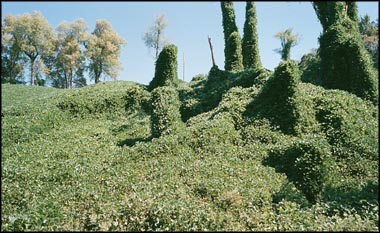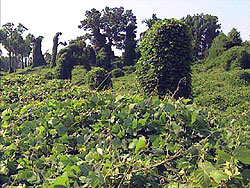
The image above was taken on my drive through the ridge between Helena and West Helena. There's an old, abandoned house beneath those lovely vines folks!
There's so much of this fast-growing vine in the Southeastern U.S., you might think it was a native plant. Actually, it took a lot of hard work to help kudzu spread so widely. Now that it covers over seven million acres of the deep South, there are a lot of people working hard to get rid of it!
Kudzu was introduced to the United States in 1876 at the Centennial Exposition in Philadelphia, Pennsylvania. Countries were invited to build exhibits to celebrate the 100th birthday of the U.S. The Japanese government constructed a beautiful garden filled with plants from their country. The large leaves and sweet-smelling blooms of kudzu captured the imagination of American gardeners who used the plant for ornamental purposes.
Florida nursery operators, Charles and Lillie Pleas, discovered that animals would eat the plant and promoted its use for forage in the 1920s. Their Glen Arden Nursery in Chipley sold kudzu plants through the mail. A historical marker there proudly proclaims "Kudzu Developed Here."
During the Great Depression of the 1930s, the Soil Conservation Service promoted kudzu for erosion control. Hundreds of young men were given work planting kudzu through the Civilian Conservation Corps. Farmers were paid as much as eight dollars an acre as incentive to plant fields of the vines in the 1940s.
"Cotton isn't king in the South anymore.
Kudzu is king!"
The problem is that it just grows too well! The climate of the Southeastern U.S. is perfect for kudzu. The vines grow as much as a foot per day during summer months, climbing trees, power poles, and anything else they contact. Under ideal conditions kudzu vines can grow sixty feet each year.

While they help prevent erosion, the vines can also destroy valuable forests by preventing trees from getting sunlight. This problem led Dr. James H. Miller of the U.S. Forest Service in Auburn, Alabama to research methods for killing kudzu. In eighteen years of research, he has found that one herbicide actually makes kudzu grow better while many have little effect. Miller recommends repeated herbicide treatments for at least four years, but some kudzu plants may take as long as ten years to kill, even with the most effective herbicides.
Common names for kudzu include:
mile-a-minute vine,
foot-a-night vine,
and the vine that ate the South.
Personally I believe that kudzu is Japan's way of finally getting even with us!

No comments:
Post a Comment